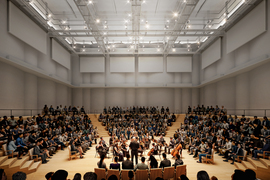More than 1,500 students enroll in music classes each year at MIT. More than 500 student musicians participate in one of 30 on-campus ensembles. In spring 2025, to better provide for its thriving musical program, MIT will inaugurate its new music building, a 35,000-square-foot three-volume facility adjacent to Kresge Auditorium. The new building will feature high-quality rehearsal and performance spaces, a professional recording studio, classrooms, and laboratories for the music technology program.
Keeril Makan is the Michael (1949) and Sonja Koerner Music Composition Professor, section head of the MIT Music and Theater Arts Section (MTA), and was recently named associate dean of the School of Humanities, Arts, and Social Sciences. A celebrated composer, Makan has been instrumental in the conception and realization of the MIT Music Building, which will also be known as Building W18. He speaks here about the ways that music helps MIT broaden and fulfill its mission, and the opportunities that the new facilities will provide.
Q: After many years of planning, the MIT Music Building is taking shape. How will this new facility change the MIT experience?
A: There is a tremendous demand on campus for the opportunity to make music and to listen to live music. Some of our students arrive at MIT already planning to study and perform music. Others pick up the passion on campus. We have such a flourishing music community here, with so many different types of ensembles we want to support. In addition to the Western Classical tradition, like our orchestra or wind ensemble, where we’ve always been strong, there is also a strong interest in jazz on campus. In fact, we’ve just hired our first jazz professor, Miguel Zenón. More and more students want to explore and experience music from other cultures. We have our Balinese Gamelan, as well as Rambax, a Senegalese drumming group that has the second-largest enrollment for an ensemble, after our orchestra. Our building is designed to allow all of these different musical traditions to exist simultaneously, all equally respected and supported.
With such a strong interest in music among our students and MIT community, the Institute is providing the proper facilities where students and faculty can pursue and develop that interest. And a big part of that is proper acoustics. At MIT we have laboratory spaces that provide stringent environmental conditions for temperature, humidity, vibration, and particulate control. Otherwise, the samples can be contaminated, and the results altered. It’s the same thing in music — we need acoustically controlled rehearsal spaces where the students hear and perform music without contamination from other sound sources. Our performance hall is designed for the audience to hear the music exactly the way the performers hear it. They will experience the music together, in a space that fosters intimacy between the performers and their audience.
Q: Will the new music building attract a different type of student to MIT?
A: I’m not sure whether the new facility will attract a different type of student as much as keep MIT competitive in attracting the type of student who will thrive here. Undergraduates and graduate students have come to expect state-of-the-art facilities across the board for their work in STEM, but also for the parts of their lives that support or complement that work. Music is a big part of that support at MIT. In order for us to stay competitive, to continue to attract the students we believe will help us further our mission, we needed to raise the bar in terms of the level of support we offer students in music. But it’s not just about being competitive in attracting gifted students. Part of our work here is taking on and providing solutions to some of the world’s most pressing and complex challenges. Solving those problems, of course, requires technical expertise. But it also requires wisdom, emotion, and compassion. Empathizing with other members of our community can lead to solutions that will make all of our lives better. And while it’s important that this new building keeps us competitive as an institution, it’s even more important for it to keep us competitive in creating the types of people best suited to take on the world’s great problems.
Q: How can music, and other arts, complement and support a student’s work in science and technology?
A: Making music is a physical activity. There is something about the small motions of the fingers, the voice resonating, that affects the body, that connects the body with what you are experiencing or feeling. It pulls you completely into the now. Having this building, right in the middle of our campus, makes it clear that this centering is important to MIT and its mission.
For the students rehearsing and performing in the building, or the students who compose music for our new facility, or for the students who will develop the hardware and software that engineers will use to produce music, the problem-solving inherent in those activities is very similar to what they do in STEM. Both are creative processes, where you learn to evaluate, manage, and integrate multiple parameters. Creating music or music technology requires you to rotate a series of different problems in your mind, and to devise a way for them to fit together. It fosters an internal desire for discovery, and for creativity. All of these are skills that, when mastered, easily translate into other activities, including scientific research, math, or engineering. MIT understands that music, and all the arts, are essential in helping our students take on the many challenges facing our world, like the climate crisis, or the impact of AI. Not just in creating an awareness of our humanity, but in training the minds and hearts of the people who will solve those issues. We now have the building that will support that crucial education.














